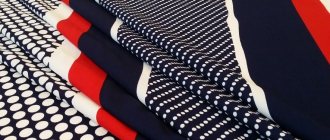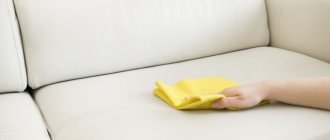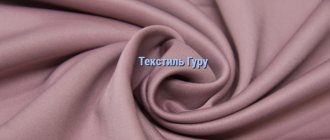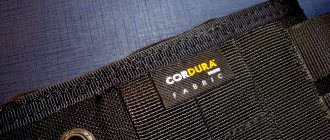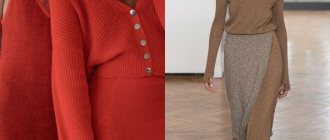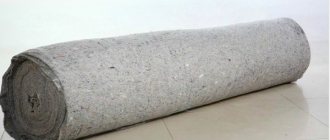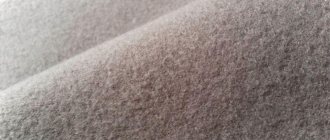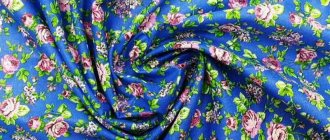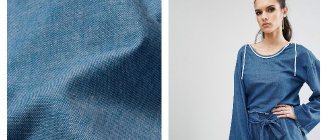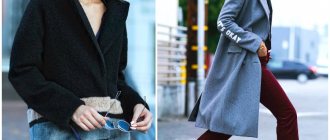The textile materials market is constantly being updated. Along with names that have been known for centuries, new names are constantly appearing in the assortment of manufacturers and sellers. One of the recent, but already widely recognized developments is micro-oil fabric.
Clothes made from this material look very impressive, are durable and easy to care for, and most importantly - very inexpensive . However, reviews of micro-oil are quite contradictory - not everyone likes such synthetic knitwear.
Description and composition
According to one version, this material comes from the United Arab Emirates: it was from there that oil knitwear came to Europe, and then spread throughout the world.
Flowy dress made of oil jersey
Residents of the East have always attached special importance to luxurious fabrics and clothes, and oil knitwear has become one of the successful options in this regard, since this material produces aesthetic and spectacular products.
The basis of such knitwear is viscose (70%), the remaining 30% of the composition is polyester, without any foreign inclusions.
This composition allows clothes made from this material to allow air to pass through well, and oil-knitted fabric does not cause irritation or discomfort on the body.
The purpose of this type of knitwear is to sew tight dresses, skirts and blouses, but thanks to the special matte finish of this material, these products do not look provocative and can serve as casual and even business wear.
In addition to the usual matte knitwear, there are other varieties:
- Cold oil (shiny canvas with a low level of density);
- Crystal oil (mainly used for sewing bright evening dresses);
- Printed fabric with a pattern;
- Winter oil (very dense material for sewing demi-season and winter dresses);
- Oil foam (a durable fabric that is ideal for sewing everyday dresses).
This is interesting: Everything about artificial and synthetic fabrics: types, production features, characteristics
Compound
In the manufacturing process, only three basic elements are used: polyester, lycra and viscose. To understand, it is worth considering the qualities of each component of the micro-oil:
- Polyester is mainly responsible for the structure, giving strength and durability. It is thanks to him that the fabric does not stretch and does not fade in sunlight. However, the polyester in the micro-oil composition does not allow air flow to circulate normally, which makes the clothes not entirely suitable for wearing on extremely hot days. Of course, the problem can be solved with a loose style, but the sensations from this will change slightly.
- Lycra is responsible for elasticity and allows the fabric to stretch. It is quite simple to use, inexpensive and wear-resistant.
- Viscose is a natural material made from cellulose. As part of micro-oil, it is used for a more pleasant and comfortable tactile sensation. Still, natural fabrics have better contact with the skin and allow air to pass through quite well.
What it is?
The first feature of this material is the fact that it was launched on the market not by recognized authorities in textile production, but by nameless companies in the Middle East. Micro oil has the following characteristics:
- high knitting density with low fabric thickness;
- softness and elasticity;
- a special composition of fibers, which, along with polyester, necessarily includes viscose and lycra (5% each).
The above fiber composition may differ slightly from one manufacturer to another, but this has little effect on the properties of the micro-oil. The combination and interweaving of threads of different compositions and thicknesses makes it possible to create a knitted fabric that is simultaneously dense, thin and elastic, as well as to enhance all the best properties of each type of fiber and partially compensate for their inherent disadvantages.
- Lycra additives ensure good stretchability of the fabric and its ability to restore its shape.
- Viscose gives micro-oil a silky shine and somewhat improves its hygienic and heat transfer properties.
- As for polyester, it guarantees the wrinkle-resistance, strength and durability of micro-oil, the ability to give it a variety of durable shades, print ornaments, and create expressive decorative effects on the surface.
Crystal knitwear with its sparkling surface is especially valued. This material lasts a long time and at the same time retains its beautiful appearance, its surface does not fade or roll off. The most attractive feature is the structure of the fabric, reminiscent of natural silk, but at the same time resistant to wrinkles and not afraid of water splashes. Micro-oil knitted material has the ability to beautifully fit and flow, create soft airy draperies without excessive volume, and also has a light, pleasant shine . However, it is not without certain disadvantages, primarily the following:
- insufficient hygroscopicity;
- poor ventilation properties;
- poor thermal insulation;
- increased risk of skin irritation and allergies;
- electrification;
- formation of puffs.
To be fair, it should be pointed out that the cheap micro-oil material made in China has these disadvantages to the greatest extent. Expensive fabrics created in the United Arab Emirates, as well as in Turkey, have much better performance characteristics and retain their decent appearance for a long time.
What kind of fabric is this?
The homeland of microoil material is the UAE. The fabric has a smooth shiny surface, drapes beautifully, and literally flows in the folds. Due to this appearance, it is called “synthetic silk”.
Micro oil composition:
- 95% polyester - for this reason the material is durable, resistant to wear and deformation;
- 5% viscose - provides breathability, hygroscopicity, smoothness and silkiness;
- 5% elastane (lycra) - responsible for the stretchability of the fabric.
Micro oil and oil are siblings. Both materials are produced on a synthetic basis and using the same method of weaving loops. The only difference is that micro-oil is a denser fabric, but their other properties are the same.
Advantages and disadvantages
The analysis of the properties of innovative fabric should start with the pros.
- The material drapes beautifully.
Chic folds, cowl collars and “waterfalls”, luxurious floor-length dresses - the possibilities of flowing fabric with iridescence in this regard are limitless. The Internet is full of videos in which home craftsmen manage to make an evening dress from microoil without a single seam, only thanks to the ability of this fabric to drape.
- Products made from the material have a cooling effect.
Touch the surface of the fabric, hold it in your hands, close your eyes. Do you feel cool? Thanks to the special weaving, clothes made from micro-oil are not at all hot.
- External resemblance to silk.
This advantage allows you to use the material for sewing fabulously beautiful evening and prom dresses, decorations and even curtains.
- Clothes made from micro-oil have a tightening effect.
The compression properties of synthetic knitwear help to visually hide extra centimeters in volume and emphasize the beauty and seductiveness of natural forms.
- Resistant to wear and deformation.
Products made from micro-oil do not lose their shape, do not stretch, and do not form pellets.
- Easy to care for.
The products are easy to wash and dry quickly. There is no need for ironing, because the fabric does not wrinkle at all.
- Clothes made from micro-oil do not fade.
Bright and rich colors remain the same even if you are in the sun all day.
There are few disadvantages, but they still exist:
- synthetic fabrics are not suitable for allergy sufferers;
- it is easy to leave a hold on the surface of the material;
- However, micro-oil does not allow air to pass through as well as natural fabrics, so you should not wear such clothes all day.
Fabric composition: micro-oil
An important property of these fabrics - with increased friction, pills do not form - significantly increases the service life, a high-quality appearance is ensured for a long time! The texture looks almost the same from the front and back, so pay special attention to the cut of the fabric when cutting - you can’t go wrong. Wash without bleach in warm water, no more than 40 degrees, and with good powders.
And the price will please you - outfits made from these fabrics are much cheaper than silk, and look even richer. One of the recent, but already widely recognized developments is micro-oil fabric. Clothes made from this material look very impressive, are durable and easy to care for, and most importantly - very inexpensive. Micro-oil is a thin knitted fabric made using special technology.
The heterogeneous nature of the threads included in the micro-oil allows us to enhance their positive characteristics and reduce their disadvantages. Summarizing numerous customer reviews, it can be argued that there are many more fans of this fabric than those who do not like it.
Kinds
Among the most common varieties are:
- Viscose fabric is a very soft knitwear that flows beautifully over the figure, forming folds. This effect is achieved due to the fact that polyester fiber is added to the fabric. The fabric is dense and very heavy, the surface is matte
- Winter oil (“Emirati knitwear”) - stretches in all directions, shines like silk, velvety to the touch. Polyester is also added to this fabric. It is slightly transparent, tolerates sun exposure well and is washable.
- Crepe butter - The material is light and practically does not wrinkle. The big advantage is that the fabric does not require ironing. It feels like sand to the touch because it is made of tightly twisted threads.
- Crystal - the fabric composition includes viscose, lycra, polyester. Most often it is painted in bright colors. It glitters beautifully and shimmers in the sun and thus resembles minerals. It looks very delicate on the figure.
- Printed oil - refers to a subspecies of colored knitwear with spraying. There is a printed design, ornament or print on the front side.
- Brushed fabric - The front side of this fabric is smooth and soft to the touch, and on the back there is viscose fluff, which forms a warm fleece.
- Cold butter - also called knitted silk. Excellent breathability and suitable for hot summer days. The material on the body feels like cool moisture, which is very pleasantly cooling, a fabric with excellent stretch and an elegant shiny surface.
- Traditional oil knitwear with a matte surface and dense structure.
- Micro oil. Photo of micro-oil fabric can be found everywhere - it is a fairly common fabric material with a lightweight structure and increased elasticity. This fabric is made using special technology. In the process, threads of different textures are intertwined. The result is a dense but airy fabric. Good for a summer wardrobe.
Characteristic
Micro oil - easy to process fabric
Micro-oil is a light, airy and at the same time dense fabric. The unique technology of combining different fibers allows you to create a delicate and wearable fabric. Micro-oil combines the wear resistance and strength of polyester, the resilience and elasticity of lycra, and the aesthetics and shine of viscose. The list of positive properties of the material does not end here:
- the fabric is easy to care for;
- the front surface does not roll off;
- dimensional stability - despite the stretching properties of the material, the products do not stretch on the elbows and knees;
- versatility - micro-oil is suitable both for use in winter and for creating summer outfits;
- does not wrinkle, does not require smoothing and special storage;
- Thanks to the synthetic composition, it dries instantly;
- aesthetic appearance, beautiful shine;
- color stability – micro-oil does not fade, is easily painted in bright colors, suitable for applying decorative prints;
- pleasant tactile sensations - the fabric is smooth, delicate, reminiscent of cool water;
- the material absorbs moisture well and evaporates it quickly;
- forms beautiful decorative folds, fits perfectly to the figure;
- The fabric is easy to process, you can sew things from it at home.
Flaws:
- low air permeability, the fabric does not breathe, so for summer use it is better to choose loose, flowing models;
- synthetic composition can cause allergies and irritation; dense products are not suitable for sensitive skin and can chafe;
- thin material should be protected from the claws of animals - contact with sharp or rough objects will inevitably damage the product;
- tight-fitting clothing not only emphasizes the advantages of the figure, but also exposes the smallest flaws of the silhouette to everyone;
- micro-oil does not warm or regulate body temperature, so in cold weather it can only perform a decorative function.
Manufacturing features and characteristics
Micro oil belongs to knitwear. A unique technology is used for production. Two threads of different texture and qualities are intertwined with each other, forming a single fabric. As a result, we get a dense, but at the same time quite loose structure. Products made from microoil are flowing and light, however, in the heat it is better to choose loose rather than tight styles.
To make fabric we use:
- Polyester;
- Lycra;
- Viscose.
The ratio of incoming elements is 90% -5% -5%. This combination gives the material special characteristics:
- Polyester provides strength and wear resistance. It helps the product dry quickly and prevents it from stretching even with constant wear. Direct sunlight does not adversely affect the surface of the fabric. However, the high ratio of polyester in the composition does not allow air to circulate freely, so tight-fitting silhouettes are best left for the cold season;
- Lycra gives the product elasticity. Most often it is used for tights and socks. It is resistant to external influences, easy to care for and prevents things from deforming over time.
- Viscose is the most natural artificial fabric. It is made from cellulose chemically. Viscose allows air to pass through well, but wrinkles a lot. The combination with polyester and lycra excludes the latter quality from the characteristics of micro-oil.
We can say that this material owes its strength to polyester, elasticity to lycra and shine to viscose.
What do they make from it?
The bulk of microoil production is focused on supplying material for clothing development. These are mainly dresses, skirts, all kinds of sweaters, capes and light raincoats. In terms of its qualities, this material is very similar to knitwear. It is used both when sewing fitted clothes and loose-fitting outfits . Various micro-oil sundresses, as well as long dresses, are quite popular. However, based on the above qualities, it is necessary to choose a style according to the season.
How to choose a micro-oil product?
The percentage of different synthetic fibers in the fabric may vary. To avoid disappointment, of course, you should buy clothes where you can try them on and touch them. After all, even with the same composition, the density of fiber weaving and their quality can differ significantly.
The best micro-oil is produced in Turkey and the UAE, the worst is the Chinese version. In the latter case, the fabric practically does not allow air to pass through and becomes terribly electrified. In any case, you should trust trusted manufacturers and stores, or even better, choose the fabric yourself and sew the product you like to order.
Absolutely everything is made from microoil - trousers, skirts, suits. The most popular are summer clothes and holiday outfits. At the same time, the cost of the products is affordable for everyone, and they look just great on any figure!
Care instructions
It’s easy to care for products made from microoil, but you should still adhere to certain rules:
- wash at temperatures up to 40 degrees (too hot water damages fabric fibers);
- do not use bleaches;
- use only non-aggressive powders and conditioners, the best option is a liquid product;
- drying only in natural conditions, no spinning in the washing machine drum!
Ironing is usually not required, but if necessary, you can use a regular iron. To do this, you need to set the “Silk” mode in its settings, wet the product and iron it carefully, only from the wrong side.
What to sew and how to wear?
Beautiful flowing micro-oil fabric is very reminiscent of natural silk, but at the same time it costs much less. It is used mainly to create elegant and casual women's clothing.
Products made from this material fit the figure very well (although they outline all the contours of the underwear), do not wrinkle or wrinkle. Happy owners of impeccable figures can afford tight clothes made from such knitwear that will emphasize their beauty and grace.
Loose, flowing models of dresses and sundresses look just as chic, giving an impressive look to ladies of any size.
It is especially advantageous to use this soft, silky knitwear when sewing long dresses, skirts, and capes . For elegant clothes, micro-oil “crystal” with a shiny surface is produced.
However, please remember that:
- In hot weather, clothing made from this material should be loose.
- Micro oil should not be worn for a long time; it is recommended to wash it as often as possible.
- People prone to allergies and skin diseases should avoid this fabric.
Caring for the material will not cause any trouble if you follow the following recommendations:
- This knitwear does not like high temperatures and aggressive detergents.
- It is washed as usual at a temperature of no more than 40 degrees, preferably using conditioner.
- A product made from micro-oil dries quickly and does not require ironing; in extreme cases, it can be ironed from the inside out in the “Silk” mode.
What can you make from micro-oil?
This fabric is used to produce:
- underwear, most often for men;
- summer clothes;
- pajamas;
- tracksuits;
- prom, evening and casual dresses;
- capes, shawls, scarves;
- home decor - curtains, elegant tablecloths.
It’s worth knowing little sewing secrets for working with micro-oil.
- If this is your first time dealing with such knitwear, it will be a little difficult to cut it. The micro-oil glides on a flat surface and does not “give” to your hands. Cover the table with flannel fabric and secure the knitted material to it with pins. This way the micro-oil will not slip, and it will be easier for you to make an even cut. But cutting out the details of the product is a real pleasure. The fabric does not fray or wrinkle at all.
- For the first experience, it is better to choose loose, flowing models with many folds. Drapery will help hide cut flaws, if any. The advantage of such models is that they are trendy and look great on any figure.
- When sewing clothes and other products made from microseam fabric, use textured thread to avoid the appearance of snags, “arrows” and other mechanical damage along the edge of the seam. Also purchase a special needle for knitwear.
Don't be afraid to experiment! But if you are still not confident in your abilities, it is better to entrust the sewing of a new dress or suit to a professional.
Construction of a knitted bodice template
There are several options for creating a pattern for the top of the product. Here you should take into account the structural features of the body. Naturally, if this is a dress for a girl without any special curves, then in this case you can not make darts on the chest and waist, but only play on the side seams.
So, the construction can be done using a regular T-shirt, the fabric structure of which is similar to that purchased for the product. The T-shirt is turned inside out, laid out on the material and chalked along the contour. Here you can do a little modeling with the shoulder seams by making a lowered sleeve, or change the neck line. In this way, the front part of the bodice and the two back halves are built.
Advantages and disadvantages
mikromaslo-7
mikromaslo-8
Like any material, there are advantages and disadvantages.
Advantages:
- Strength and wear resistance;
- Pellets are not formed even with prolonged use;
- Elasticity;
- Resistance to negative external influences;
- Depending on the style, they are good both in summer and winter;
- Fast drying time;
- No ironing required;
- Does not stretch or deform during prolonged wear;
- Pleasant unobtrusive shine;
- They do not shed;
- Easy care;
- Silky and soft to the touch;
- Hygroscopicity;
- Draps easily.
Flaws:
- Poor air permeability;
- With sensitive skin, it can cause allergies (especially when the body is overheated);
- If you choose a tight-fitting silhouette, it can highlight all the imperfections of your figure. Although this drawback can be attributed more to the peculiarities of the choice of style.
Description
So, let's start with a description of oil fabric - it is a heavy and very dense knitwear, which, at the same time, stretches very well, does not deform, fits the figure or forms beautiful draperies.
Oil knitwear is a fabric with a different surface - matte, glossy, brushed, which allows it to be used for a variety of purposes. But at the same time, the material will always be soft and silky, in fact, that’s why it got its name – “butter”.
You can see what the material and products made from it look like in the photo.
Cost - from 160 rubles per meter, depending on the composition.
Care
Overalls
Under normal conditions, oil jersey is very durable, but since the material is synthetic, it is vulnerable to certain chemicals and to high water temperatures during washing.
Therefore, items made from this type of knitwear can only be washed in a delicate cycle using powders that do not contain aggressive additives.
When ironing, the iron should not be heated above 110 degrees (silk is also ironed at the same temperature), and the product itself must be moistened with water during the ironing process or ironed slightly under-dried after washing.
What is unique about Navratna anti-hair loss hair oil | Navratna Oil Himani 100ml?
This natural remedy, created according to Ayurvedic recipes, has amazing healing properties that effectively improve well-being. It has the following therapeutic effect:
- Cools the scalp.
- Strengthens blood microcirculation.
- Relieves headaches.
- Improves sleep and fights insomnia.
- Tones.
- Eliminates signs of fatigue.
- Relieves muscle tension during cramps.
- Prevents hair loss and baldness.
- Prevents early graying.
- Fights dandruff.
- Activates hair growth and volume.
This product can be used for head and body massage. Its light consistency is quickly absorbed and leaves no greasy residue. The peculiarity of the product is its red color, so if the oil was used on the body, it is better not to wear white clothes.
Application area
micromaslo-izdelia-1
micromaslo-izdelia-3
micromaslo-izdelia-2
micromaslo-izdelia4
Micro oil is used for sewing clothes. These are mainly dresses, skirts, sweaters, capes and light raincoats. The properties of the fabric are similar to knitwear. This material makes interesting things, both loose-fitting and fitted. Models of dresses, skirts and floor-length sundresses look especially interesting.
However, based on the above qualities, it is necessary to choose a style according to the season. This will help you stay warm in the winter and not sweat in the summer!
Application
Fabric oil, what is it? It is actively used for sewing fitted dresses, flowing skirts, wedding trousers, golf pants, blouses, and tracksuits. By and large, it is well suited for sewing any beautiful but practical things to use (not only for women, but also for men). You can read more about materials for clothing in the corresponding section on our website. You can see what it looks like in the photo.
